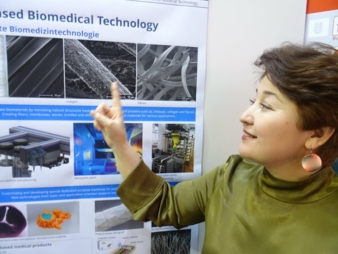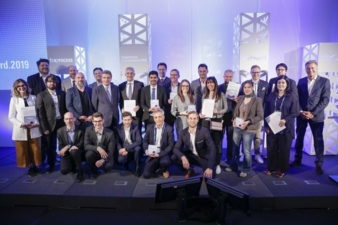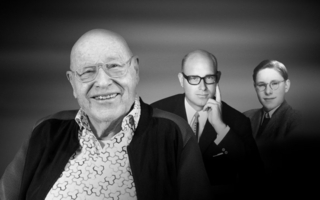28/08/2019 – Drum roll for an artificial eardrum — auf Deutsch lesen
Future applications for textiles
It is thanks mainly to research that innovations such as artificial eardrums and textile mining filters are paving the way for new applications in the future.
Visitors to the twin fairs Techtextil/Texprocess soon come to appreciate that few sectors serving other industries are as innovative as textiles. textile network took a good look around at both fairs.
ITM/TU Dresden:
It may look like an igloo with a barred window but in reality it is an application model for multi-axially warp-knitted 3D reinforcement lattices. With this technology, the Institute of Textile Machinery and High-Performance Material Technology (ITM) is opening the door to new opportunities in textile construction and architecture. Such reinforcement lattices in textile concrete follow the “Form follows Force” principle and secure the need-based distribution of forces in highly complex 3D integral composite parts.
Dr. Dilbar Aibibu, Head of Biotextiles and Medical Textiles Research at the ITM, draws our attention to medical electro-spinning applications in the context of cardiac valves and the generation of cartilage. Particularly striking is a development which could facilitate the correction of serious eardrum defects, albeit in the perhaps more distant medical future. The prototype transplant, developed in collaboration with ENT specialists in Dresden, is made from bio-compatible material. It is a biomimetic imitation of the human ear membrane and is endowed with similar acoustic-mechanical properties to the real thing.
ITA/RWTH Aachen:
Lighter, lighter and lighter still ... Not only the field of e-mobility but also the aviation and aerospace industries are constantly searching for new technologies. Lightweight tanks made from fibre composite materials could be one such development, demonstrated by the ITA in Frankfurt initially “only” in a remote-controlled model vehicle powered by fuel cells.
If the hydrogen pressure tank is “wrapped” in carbon fibres using a multifilament winding process, this technology suddenly becomes far more affordable than conventional wet wrapping methods. As part of an emission-free drive train with a long range and significant weight reductions compared to batteries, the tank can withstand pressures up to 700 bar.
STFI Chemnitz:
For the past ten years, the STFI in Chemnitz (Sächsisches Textilforschungsinstitut) has been developing high-strength textile materials that are quite literally bombproof. Containers made from such materials could be used in areas susceptible to terrorism such as aviation, but also on the ground in the logistics sector. “Suspicious” parcels, for example, could be transported in flexible boxes either until their disposal or the all-clear has been given. The Institute is confident that, once a production partner has been found, the research results of numerous programmes will be translated into a range of different safety products.
TITK Greiz:
How do man and machine interact in the digital age? A possible answer to this question was offered by textile machinery maker Karl Mayer and the TITV textile research institute in Greiz with their interactive motion control. The infrared control sleeve comprising a conductive knitted textile works like a non-contact switch. Still in the laboratory phase, the touch electronics are currently capable of controlling a toy remotely. With high-performance electronics “on the inside”, everything previously needing a remote control could be controlled in this way. A new human-machine interface with great potential...
Techtextil Awards:
The industry-oriented German textiles institutes are currently driving innovation. As a result, two of the seven Techtextil Innovation Awards 2019 went to industry researchers in Krefeld and Denkendorf.
DTNW Krefeld:
Whenever the DTNW (Deutsche Textilforschungszentrum Nord-West) is honoured for its research achievements in the textile-based reclamation of precious metals, it is usually Dr. Klaus Opwis who ascends the winner’s podium. This was certainly the case with the German Prize for Raw Materials Efficiency in 2014, corresponding regional prizes awarded by the state of North-Rhine Westphalia – and most recently at the Awards Ceremony on the opening day of Techtextil. Here, the international jury commented that the scientist’s adsorber textiles for reclaiming precious metals from industrial wastewater, had opened a new chapter in recycling. The accolade was awarded in the “New Technology” category.
The specialised textiles are already capable of recovering palladium from weakly concentrated electroplating wastewater both cheaply and efficiently. Initial trials have shown that for every kilogramme of textile filter, around EUR 1,000 worth of palladium can be reclaimed.
The patented process which selectively binds substances such as platinum, gold, silver but also ammonia and arsenic, uses affordable base materials such as polyester and polyvinylamine. Practical trials are currently running at two company sites prior to market launch. When the time comes, a spin-off company will probably be established.
Dr. Opwis believes that it will also be possible in the medium term to recover from secondary raw material sources a range of strategic metals such as indium, gallium, niobium, tantalum and rare earths such as lanthanum.
DITF Denkendorf:
In the “New Application” category, the DITF (Deutsche Institute für Textil- und Faserforschung Denkendorf), working in cooperation with Robert Bosch GmbH, received an award for the development of a space-saving inductive charging coil for hybrid and electric cars. The knitted 3.3KW demonstrator meets all requirements in terms of heat dissipation and electrical safety. Here are just two of the problems that had to be overcome during the development phase: On the one hand, it was important to ensure that the relatively rigid metal (copper) strands and the far more flexible, yet thin embroidery threads (polyester) could be processed together. On the other hand, a special construction shape had to be designed. This is because, for space reasons, it is difficult to install non-contact charging coils on the underside of a car in such a way that the correct and constant amount of voltage needed to charge large batteries, is available across the entire coil. To overcome this challenge, the DITF has exploited the opportunities offered by high-tech embroidery technology.





